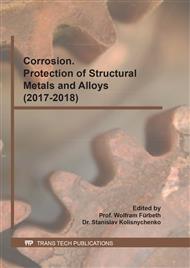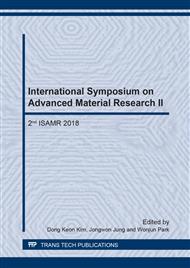p.3
p.11
p.17
p.25
p.31
p.39
p.45
p.51
p.57
Effect of Osmotic Pressure by Salt Concentration on Corrosion Resistance of Anti-Corrosive Paint
Abstract:
Recently, many types of constructional steels have been often exposed to severely corrosive environments due to acid rain with increasing environmental contamination. To control corrosion problems, a painting protection method has been widely applied to numerous constructional steels on land as well as offshore. Therefore, development of anti-corrosive paint with good quality of corrosion resistance is very important from an economical perspective. In this study, four types of anti-corrosive paint were coated to test specimens, and then, were immersed in various salt solutions (0.1, 3 and 9% NaCl solution) for 11 days. Corrosion resistance of these samples by effect of osmotic pressure with various salt concentration was investigated with electrochemical methods such as measurement of corrosion potential, impedance and corrosion current density. Corrosion current density of these samples submerged in 0.1% NaCl solution exhibited highest value than those immersed in 3% and 9% NaCl solutions because water, dissolved oxygen and chloride ion etc. is easily to invade towards inner side of coating film due to increasing osmotic pressure compared to 3% and 9% NaCl solutions. However, corrosion current densities of all samples in the case of submerged in 9% NaCl solution exhibited higher values compared to 3% NaCl solution.Thus, a large amount of chloride ion dissolved in 9% NaCl solution plays a more critical role in corrosion behavior of coated steel rather than osmotic pressure. Consequently, the corrosion mechanism between coated steel and bare steel plates is different from each other because of presence of osmotic pressure between salt solution and coating film of coated steel plate. As a result, corrosion resistance of tcoated steel plate may be depend on the osmotic pressure as well as salt concentration
Info:
Periodical:
Pages:
31-36
Citation:
Online since:
July 2018
Authors:
Price:
Сopyright:
© 2018 Trans Tech Publications Ltd. All Rights Reserved
Share:
Citation:



